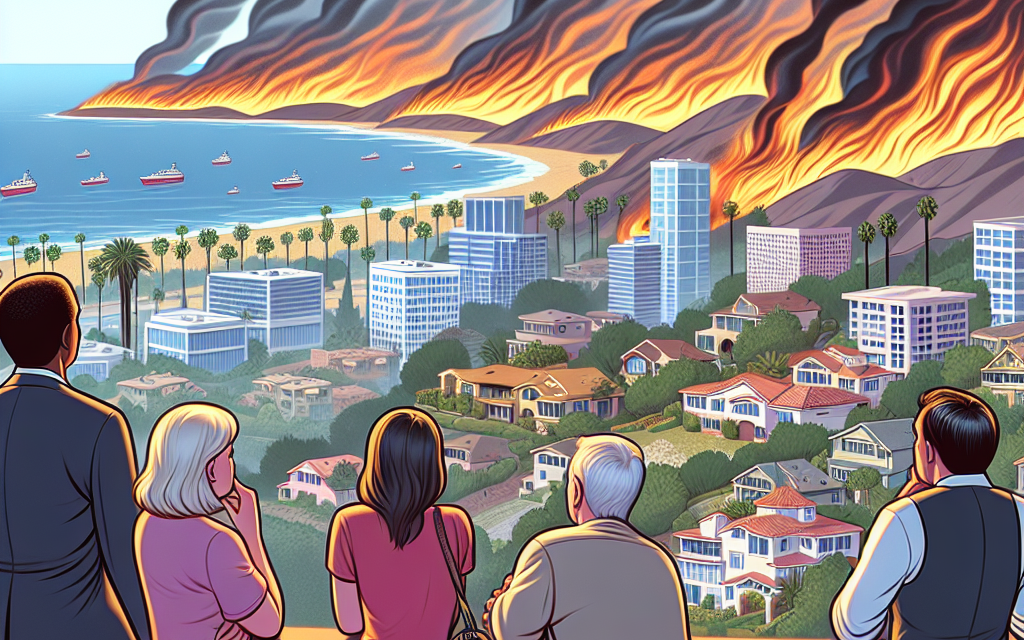“Pacific Palisades Fire: A Warning Sign for the Future of Affordable Homeowners Insurance in California.”
Introduction
The recent Pacific Palisades fire has raised significant concerns about the future of affordable homeowners insurance in California. As wildfires become increasingly frequent and intense due to climate change, insurers are reevaluating their risk assessments and coverage options. This situation highlights a growing crisis in the state, where many homeowners may find themselves facing skyrocketing premiums or even the inability to secure coverage altogether. The implications of this trend could lead to a housing market crisis, exacerbating the challenges faced by residents in high-risk areas and prompting urgent discussions about the sustainability of insurance models in the face of natural disasters.
Pacific Palisades Fire: A Wake-Up Call for Homeowners Insurance
The recent Pacific Palisades fire has ignited a critical conversation about the future of homeowners insurance in California, particularly in areas prone to wildfires. As flames engulfed homes and threatened communities, the incident served as a stark reminder of the increasing risks associated with living in fire-prone regions. This catastrophic event not only devastated property but also highlighted the precarious state of the insurance market, which is grappling with the dual challenges of rising claims and shrinking coverage options.
In the aftermath of such disasters, insurance companies often reassess their risk exposure, leading to significant changes in policy offerings. For many homeowners, this means facing higher premiums or, in some cases, the inability to secure coverage altogether. The Pacific Palisades fire exemplifies a growing trend where insurers are retreating from high-risk areas, leaving homeowners vulnerable and uncertain about their financial futures. As the frequency and intensity of wildfires increase, driven by climate change and urban development, the implications for homeowners insurance become increasingly dire.
Moreover, the Pacific Palisades fire is not an isolated incident; it is part of a broader pattern affecting many regions across California. The state has witnessed a series of devastating wildfires over the past few years, each one prompting insurers to tighten their underwriting standards. Consequently, homeowners in affected areas may find themselves facing exorbitant rates or being dropped altogether by their insurance providers. This trend raises significant concerns about the affordability and availability of homeowners insurance, particularly for those who may already be struggling financially.
As the insurance landscape shifts, homeowners are left to navigate a complex web of options, often with limited resources. Many are forced to turn to the California FAIR Plan, a state-sponsored program designed to provide coverage for high-risk properties. However, this plan often falls short of comprehensive coverage, leaving homeowners exposed to significant financial risks. The reliance on such programs underscores the urgent need for a reevaluation of how homeowners insurance is structured in the state, particularly in light of the increasing frequency of natural disasters.
In addition to the immediate financial implications, the Pacific Palisades fire raises broader questions about community resilience and preparedness. Homeowners must consider not only their insurance options but also the steps they can take to mitigate risks. This includes investing in fire-resistant materials, creating defensible space around properties, and participating in community fire prevention initiatives. By taking proactive measures, homeowners can potentially lower their insurance costs while also contributing to the overall safety of their neighborhoods.
Furthermore, policymakers must engage in meaningful dialogue with insurance companies to develop sustainable solutions that address the challenges posed by climate change and urban development. This may involve incentivizing insurers to offer more affordable coverage options or creating programs that support homeowners in implementing risk-reduction strategies. Ultimately, the Pacific Palisades fire serves as a wake-up call, urging all stakeholders to collaborate in finding innovative solutions that ensure the long-term viability of homeowners insurance in California.
In conclusion, the Pacific Palisades fire is a pivotal moment for homeowners insurance in California, signaling a potential shift towards unaffordable coverage options for many. As the state grapples with the realities of climate change and increasing wildfire risks, it is imperative for homeowners, insurers, and policymakers to work together to create a more resilient and equitable insurance landscape. Only through collective action can we hope to safeguard the future of homeowners insurance and protect the communities that call California home.
The Impact of Wildfires on California’s Insurance Market
The increasing frequency and intensity of wildfires in California have profound implications for the state’s insurance market, particularly concerning homeowners insurance. As wildfires become more prevalent, the risks associated with insuring properties in fire-prone areas have escalated, leading to significant shifts in how insurance companies operate. This evolving landscape is not only affecting the availability of coverage but also the affordability of premiums for homeowners across the state.
In recent years, catastrophic wildfires have ravaged vast swathes of California, resulting in billions of dollars in damages. The aftermath of these disasters has prompted insurance companies to reassess their risk models, often leading to higher premiums for homeowners in affected regions. As insurers grapple with the financial repercussions of these fires, many have begun to withdraw from high-risk markets altogether. This trend is particularly alarming for residents in areas like Pacific Palisades, where the threat of wildfires looms large. The withdrawal of insurers from these markets can create a vicious cycle; as fewer companies offer coverage, those that remain may raise their rates significantly, making it increasingly difficult for homeowners to afford insurance.
Moreover, the situation is exacerbated by the fact that California’s regulatory environment limits how much insurers can raise premiums in response to increased risk. While these regulations are designed to protect consumers, they can inadvertently lead to a situation where insurers are unable to adequately price their products based on the actual risk they face. Consequently, some companies may opt to exit the market entirely rather than continue to operate at a loss. This trend not only reduces competition but also limits options for homeowners seeking affordable coverage.
As the insurance market contracts, homeowners may find themselves in a precarious position. Those living in high-risk areas may struggle to secure coverage at any price, while others may be forced to turn to the state’s FAIR Plan, a last-resort option that provides basic fire insurance but often lacks comprehensive coverage. The FAIR Plan is not designed to be a long-term solution, and its limited scope can leave homeowners vulnerable to significant financial losses in the event of a disaster. This situation raises critical questions about the future of affordable homeowners insurance in California, particularly as climate change continues to exacerbate the frequency and severity of wildfires.
In addition to the immediate financial implications for homeowners, the broader economic impact of these changes cannot be overlooked. As insurance becomes less accessible and more expensive, property values in high-risk areas may decline, leading to a decrease in local tax revenues and potentially straining public services. Furthermore, the inability to secure affordable insurance can deter potential buyers from entering the market, stifling economic growth in regions already grappling with the effects of climate change.
In conclusion, the ongoing wildfire crisis in California is reshaping the insurance landscape in ways that could signal the end of affordable homeowners insurance for many residents. As insurers reevaluate their risk exposure and adjust their offerings accordingly, homeowners are left to navigate a complex and increasingly challenging market. The implications of these changes extend beyond individual homeowners, affecting entire communities and the state’s economy as a whole. As California continues to confront the realities of climate change, finding sustainable solutions to ensure affordable and accessible homeowners insurance will be crucial for the well-being of its residents.
Rising Costs: How the Pacific Palisades Fire Affects Homeowners Insurance Rates
The recent Pacific Palisades fire has raised significant concerns regarding the future of homeowners insurance in California, particularly in areas prone to wildfires. As the frequency and intensity of such natural disasters increase, insurance companies are reevaluating their risk assessments and pricing strategies. This shift is not merely a reaction to a single event; rather, it reflects a broader trend that has been developing over the past few years as climate change exacerbates the risks associated with living in fire-prone regions.
In the wake of the Pacific Palisades fire, homeowners are likely to experience a surge in insurance premiums. Insurers, facing mounting claims and losses, are compelled to adjust their rates to maintain financial viability. This adjustment often translates to higher costs for policyholders, particularly in high-risk areas. As a result, many homeowners may find themselves grappling with the reality of unaffordable insurance premiums, which could lead to a significant shift in the housing market. The implications of this trend extend beyond individual homeowners; they could also affect property values and the overall desirability of living in certain regions.
Moreover, the Pacific Palisades fire serves as a stark reminder of the vulnerabilities inherent in California’s housing landscape. As wildfires become more frequent, the insurance industry is likely to adopt stricter underwriting criteria. This means that homeowners in high-risk areas may face challenges in obtaining coverage altogether. Insurers may impose additional requirements, such as fire-resistant materials or defensible space around properties, further complicating the situation for those seeking affordable insurance options. Consequently, homeowners may be forced to invest in costly upgrades to their properties, which can strain their finances and deter potential buyers.
In addition to rising premiums and stricter underwriting practices, the Pacific Palisades fire could also lead to a reduction in the availability of insurance products. Some insurers may choose to exit the market altogether, particularly in regions deemed too risky. This contraction could leave homeowners with fewer options, forcing them to rely on state-backed programs or high-risk insurance pools that often come with exorbitant costs. As the market tightens, the concept of affordable homeowners insurance may become increasingly elusive for many Californians.
Furthermore, the implications of these changes extend beyond individual homeowners. As insurance becomes more expensive and less accessible, the overall housing market may experience a downturn. Potential buyers may be deterred by the prospect of high insurance costs, leading to decreased demand for homes in fire-prone areas. This shift could result in declining property values, which would further exacerbate the financial challenges faced by current homeowners. In this context, the Pacific Palisades fire serves as a critical juncture, highlighting the urgent need for comprehensive solutions to address the growing risks associated with climate change and its impact on homeowners insurance.
In conclusion, the Pacific Palisades fire is not just a localized disaster; it is a harbinger of broader changes in the homeowners insurance landscape in California. As rising costs and reduced availability of coverage become more prevalent, homeowners may find themselves navigating an increasingly complex and challenging environment. The need for proactive measures, including policy reforms and community resilience initiatives, has never been more pressing. Without such interventions, the dream of affordable homeowners insurance may slip further out of reach for many Californians, fundamentally altering the fabric of communities across the state.
The Future of Affordable Homeowners Insurance in California
The recent Pacific Palisades fire has raised significant concerns regarding the future of affordable homeowners insurance in California. As wildfires become increasingly frequent and intense due to climate change, insurance companies are reevaluating their risk assessments and pricing models. This shift is not merely a reaction to a single event; rather, it reflects a broader trend that could fundamentally alter the landscape of homeowners insurance in the state. The implications of this trend are profound, particularly for homeowners in high-risk areas who may find themselves facing skyrocketing premiums or, in some cases, an inability to secure coverage altogether.
In California, the interplay between natural disasters and insurance has long been a contentious issue. The state has experienced a series of devastating wildfires over the past few years, leading to substantial losses for insurance companies. As a result, many insurers are now adopting more stringent underwriting practices, which often translate into higher premiums for homeowners. This situation is exacerbated by the fact that California has a unique regulatory environment that limits how much insurers can raise rates in response to increased risk. Consequently, many companies are opting to withdraw from high-risk markets entirely, leaving homeowners with fewer options and potentially unaffordable premiums.
Moreover, the Pacific Palisades fire serves as a stark reminder of the vulnerabilities that many communities face. As the frequency of such disasters increases, the concept of insurability itself is being called into question. Insurers are beginning to assess not only the immediate risks associated with wildfires but also the long-term viability of providing coverage in areas that are becoming increasingly hazardous. This shift could lead to a scenario where entire neighborhoods are deemed uninsurable, effectively pricing out residents who cannot afford the rising costs or who are unable to find coverage at all.
In light of these developments, it is essential for policymakers to consider innovative solutions that can help stabilize the homeowners insurance market. One potential avenue is the establishment of state-backed insurance programs that could provide coverage in high-risk areas. Such programs could help mitigate the financial burden on homeowners while ensuring that insurers remain solvent. Additionally, investing in community resilience initiatives, such as improved firebreaks and better land management practices, could reduce the overall risk of wildfires and, in turn, the cost of insurance.
Furthermore, public awareness and education about risk mitigation strategies are crucial. Homeowners can take proactive steps to protect their properties, such as creating defensible space around their homes and utilizing fire-resistant building materials. By fostering a culture of preparedness, communities can not only reduce their vulnerability to wildfires but also potentially influence insurance pricing models favorably.
As California grapples with the implications of climate change and its impact on homeowners insurance, the Pacific Palisades fire serves as a critical juncture. The decisions made in the coming years will shape the future of affordable homeowners insurance in the state. It is imperative for stakeholders, including insurers, policymakers, and homeowners, to engage in constructive dialogue aimed at finding sustainable solutions. Only through collaboration and innovation can California hope to navigate the challenges posed by an increasingly volatile climate while ensuring that homeowners can maintain access to affordable insurance coverage. The stakes are high, and the time for action is now.
Lessons Learned from the Pacific Palisades Fire for Homeowners
The recent Pacific Palisades fire has underscored the precarious state of homeowners insurance in California, particularly for those residing in high-risk areas. As the flames engulfed homes and threatened entire neighborhoods, it became evident that the implications of such disasters extend far beyond immediate property damage. Homeowners are now faced with the daunting reality that the availability and affordability of insurance may be on the brink of significant change. This situation serves as a critical lesson for homeowners, emphasizing the need for proactive measures and a deeper understanding of their insurance policies.
One of the most pressing lessons from the Pacific Palisades fire is the importance of assessing and understanding the risks associated with living in fire-prone areas. Homeowners must recognize that their geographical location plays a pivotal role in determining their insurance premiums and coverage options. As wildfires become increasingly frequent and severe due to climate change, insurers are reevaluating their risk models, which can lead to higher premiums or even the denial of coverage altogether. Therefore, it is essential for homeowners to stay informed about their local fire risk and to consider this factor when purchasing or renewing their insurance policies.
Moreover, the Pacific Palisades fire highlights the necessity of maintaining an updated home inventory. In the chaos of a disaster, having a comprehensive list of personal belongings can significantly streamline the claims process. Homeowners should take the time to document their possessions, including photographs and receipts, to ensure they are adequately covered in the event of a loss. This proactive approach not only aids in expediting claims but also serves as a reminder of the value of one’s assets, reinforcing the need for sufficient coverage.
In addition to understanding risks and maintaining an inventory, homeowners should also engage in regular communication with their insurance providers. As the landscape of homeowners insurance evolves, it is crucial to stay abreast of any changes in policy terms, coverage limits, and exclusions. Homeowners should not hesitate to ask questions or seek clarification on aspects of their policies that may be unclear. This dialogue can help ensure that they are adequately protected and can also provide insights into potential adjustments that may be necessary as risks change over time.
Furthermore, the Pacific Palisades fire serves as a stark reminder of the importance of community preparedness. Homeowners should consider collaborating with neighbors to develop a collective response plan in the event of a wildfire. This could include creating defensible space around homes, participating in local fire safety programs, and staying informed about evacuation routes and emergency services. By fostering a sense of community resilience, homeowners can enhance their safety and potentially mitigate the impact of future disasters.
Lastly, as the insurance landscape continues to shift, homeowners may need to explore alternative coverage options. This could involve looking into specialized insurance providers that cater to high-risk areas or considering additional policies that offer supplemental coverage. By diversifying their insurance portfolio, homeowners can better protect themselves against the uncertainties that lie ahead.
In conclusion, the lessons learned from the Pacific Palisades fire are multifaceted and serve as a wake-up call for homeowners across California. By understanding risks, maintaining thorough documentation, engaging with insurance providers, fostering community preparedness, and exploring alternative coverage options, homeowners can navigate the evolving landscape of homeowners insurance with greater confidence and security. As the state grapples with the implications of climate change and its impact on insurance, these proactive measures will be essential in safeguarding both property and peace of mind.
Government Response to Wildfire Risks and Insurance Challenges
The recent Pacific Palisades fire has reignited discussions surrounding the precarious state of homeowners insurance in California, particularly in areas prone to wildfires. As the frequency and intensity of wildfires continue to escalate, the government’s response to these risks has become increasingly critical. The interplay between wildfire management and insurance availability is complex, and the implications for homeowners are profound.
In recent years, California has witnessed a series of devastating wildfires, prompting state officials to reevaluate their strategies for managing these natural disasters. The government has implemented various measures aimed at reducing wildfire risks, including increased funding for fire prevention programs, enhanced forest management practices, and the establishment of defensible space regulations. These initiatives are designed to mitigate the impact of wildfires on communities, yet they also highlight the challenges faced by the insurance industry in assessing risk and determining coverage options.
As wildfires become more frequent, insurance companies are grappling with the financial implications of insuring properties in high-risk areas. Many insurers have responded by raising premiums, limiting coverage, or even withdrawing from certain markets altogether. This trend has left many homeowners in vulnerable positions, as they struggle to find affordable insurance options. The Pacific Palisades fire serves as a stark reminder of the urgent need for a comprehensive approach to wildfire risk management that includes not only prevention and response strategies but also sustainable insurance solutions.
In response to these challenges, state lawmakers have begun to explore potential reforms aimed at stabilizing the homeowners insurance market. One proposed solution involves the creation of a state-backed insurance program that would provide coverage for homeowners in high-risk areas. This initiative seeks to ensure that residents can access affordable insurance while also encouraging responsible land use and fire prevention practices. However, the feasibility of such a program remains a topic of debate, as it raises questions about funding, risk assessment, and the long-term sustainability of state involvement in the insurance market.
Moreover, the government’s role in regulating insurance practices is under scrutiny. Some advocates argue that stricter regulations are necessary to protect consumers from exorbitant rate increases and to ensure that insurance companies remain accountable for their coverage decisions. On the other hand, insurers contend that they must adjust their policies to reflect the realities of climate change and the increasing likelihood of catastrophic events. This tension between consumer protection and market viability complicates the development of effective policies that address both wildfire risks and insurance challenges.
As California continues to grapple with the consequences of climate change, the need for innovative solutions becomes ever more pressing. Collaborative efforts between government agencies, insurance companies, and local communities are essential to create a resilient framework that addresses the dual challenges of wildfire management and insurance accessibility. By fostering dialogue and cooperation among stakeholders, it may be possible to develop strategies that not only protect homeowners but also promote sustainable practices that reduce wildfire risks.
In conclusion, the Pacific Palisades fire serves as a critical juncture in the ongoing conversation about wildfire risks and the future of homeowners insurance in California. The government’s response to these challenges will play a pivotal role in shaping the landscape of insurance availability and affordability. As the state navigates this complex terrain, it is imperative that all parties work together to forge solutions that ensure the safety and security of California’s residents while addressing the realities of an increasingly volatile environment.
Strategies for Homeowners to Mitigate Insurance Costs Post-Fire
In the wake of the devastating Pacific Palisades fire, homeowners in California are increasingly confronted with the harsh reality of rising insurance costs. As insurers reassess their risk exposure in fire-prone areas, many residents find themselves facing steep premium hikes or, in some cases, the inability to secure coverage altogether. Consequently, it becomes imperative for homeowners to adopt strategies that can help mitigate these escalating insurance costs while ensuring adequate protection for their properties.
One of the most effective strategies homeowners can employ is to enhance the fire resistance of their properties. This can be achieved through a variety of measures, such as using fire-resistant building materials for roofing, siding, and decks. Additionally, creating defensible space around the home by clearing flammable vegetation and maintaining a well-manicured landscape can significantly reduce the risk of fire damage. Insurers often reward homeowners who take proactive steps to minimize risk, which can lead to lower premiums. Therefore, investing in fire-resistant upgrades not only protects the home but also serves as a long-term financial strategy.
Moreover, homeowners should consider conducting a thorough review of their insurance policies. This involves understanding the coverage limits, deductibles, and exclusions that may apply. By engaging in open communication with their insurance agents, homeowners can identify potential gaps in coverage and explore options for adjusting their policies to better suit their needs. For instance, increasing the deductible may lower the premium, although it is essential to ensure that the deductible remains manageable in the event of a claim. Additionally, bundling home insurance with other types of coverage, such as auto insurance, can often yield discounts, further alleviating financial burdens.
Another avenue for cost reduction lies in the pursuit of multiple insurance quotes. Homeowners should not hesitate to shop around and compare rates from different insurers. Each company has its own underwriting criteria and risk assessment models, which can lead to significant variations in premium costs. By obtaining quotes from various providers, homeowners can identify the most competitive rates and potentially save a substantial amount on their insurance premiums. Furthermore, some insurers offer discounts for specific affiliations, such as membership in certain organizations or professional associations, which can also contribute to cost savings.
In addition to these strategies, homeowners should remain informed about state regulations and programs designed to assist those affected by wildfires. California has implemented various initiatives aimed at providing financial relief and support to homeowners facing insurance challenges. By staying abreast of these developments, homeowners can take advantage of available resources that may help offset costs or provide alternative coverage options.
Lastly, fostering a community approach to fire safety can also play a crucial role in mitigating insurance costs. By collaborating with neighbors to create a community-wide fire prevention plan, homeowners can enhance the overall safety of their area, which may positively influence insurance rates. Insurers often consider the collective risk of a neighborhood when determining premiums, so a proactive community can lead to more favorable insurance terms for all residents.
In conclusion, while the Pacific Palisades fire serves as a stark reminder of the increasing challenges associated with homeowners insurance in California, there are several strategies that homeowners can implement to mitigate costs. By enhancing fire resistance, reviewing insurance policies, shopping for competitive quotes, staying informed about state programs, and fostering community collaboration, homeowners can navigate the complexities of insurance in a post-fire landscape and secure their financial well-being.
Q&A
1. **What is the Pacific Palisades fire?**
The Pacific Palisades fire refers to a significant wildfire that occurred in the Pacific Palisades area of Los Angeles, California, threatening homes and prompting evacuations.
2. **How does the Pacific Palisades fire impact homeowners insurance?**
The fire increases the risk assessment for insurers, leading to higher premiums and potentially making it difficult for homeowners to obtain affordable insurance.
3. **What trends are emerging in California’s homeowners insurance market?**
Insurers are increasingly withdrawing coverage or raising rates in high-risk areas due to the frequency and severity of wildfires, which may signal a broader trend of unaffordability.
4. **What are the implications for homeowners in fire-prone areas?**
Homeowners may face skyrocketing insurance costs, reduced coverage options, or even the inability to secure insurance, which can affect property values and market stability.
5. **What actions are being taken by the state of California regarding homeowners insurance?**
California has implemented measures to stabilize the insurance market, such as creating a state-backed insurance program for high-risk areas, but challenges remain.
6. **How does the Pacific Palisades fire relate to climate change?**
The increasing frequency of wildfires, including the Pacific Palisades fire, is often linked to climate change, which exacerbates conditions conducive to wildfires, impacting insurance viability.
7. **What can homeowners do to mitigate insurance challenges?**
Homeowners can take steps to reduce fire risk on their properties, such as creating defensible space, using fire-resistant materials, and staying informed about insurance options and state programs.
Conclusion
The Pacific Palisades fire highlights the growing risk of wildfires in California, which may lead to increased insurance premiums and reduced availability of affordable homeowners insurance. As insurers face mounting claims and financial pressures, the trend could signal a shift towards higher costs and limited coverage options for homeowners, particularly in high-risk areas. This situation underscores the urgent need for policy reforms and innovative solutions to ensure that homeowners can maintain access to affordable insurance while addressing the realities of climate change and wildfire risks.





